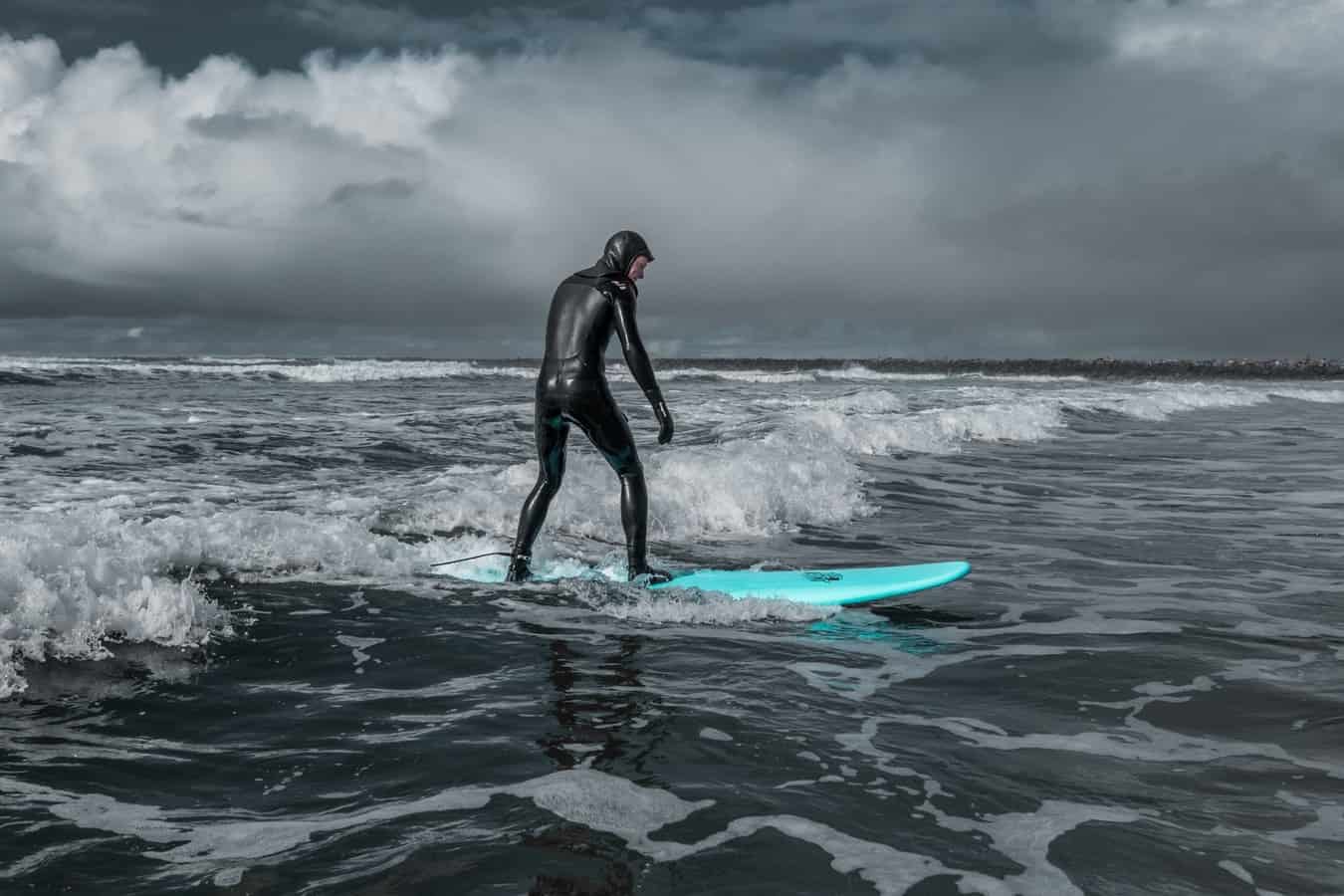The standard in the surfing world has been the polyurethane longboard. “Poly boards” as they are called, have been loved by surfers at every level of experience for their response and a smooth ride on the waves, and their buoyancy. There was no real competitor until late 2005, when Grubby Clark, the owner of Clark foam and the supplier of 90% of the polyurethane foam cores for surfboards, closed its door forever, leaving makers of surfboards a huge challenge – and opportunity – to come up with an alternative. What they came up with was an epoxy core foam surfboard, and since then, sales of “foamies” have spiked as more and more surfers take to epoxy-based boards.
Should you buy a foam surfboard? Our thoughts on foamies are that foam surfboards are a great alternative to poly boards, especially for beginners. But experienced surfers can have a great time riding foamies as well. Today, it’s a common thing to see surfers at all levels carry foam boards out to the beach.
Why Should I Use A Foam Surfboard?
Experienced surfers themselves learned how to surf on foam surfboards because of all the advantages they provide. Foam boards are lighter compared to poly boards. Their volume, and buoyancy, is higher than most poly boards unless the poly board is custom made. Safety is a big consideration when buying a surfboard and foamies are light enough so that surfers won’t get hurt if the board hits them. Wipe outs are common in surfing, and surfers expect to fall off the board frequently in each surfing session.
A surfer paddles and pops up off the board on their approach. Foam boards make it easier to pop up then a polyurethane board. Foam boards have a high volume rating, making it easier to paddle through waves.
Fiberglass boards require a lot more effort to paddle towards waves. To pop up, you’ll need to be good at balancing while standing, even if the board is waxed. Poly boards only work when the wave catches the nose of the board and requires the wave’s power to ride; it is not required for foam boards to get into the wave-current so that you can ride.
This means that surfers with foam boards don’t need huge waves to ride. Whitewater waves are accessible with foamies, but there is not enough power in the wave for poly boards to ride. Certain specific conditions need to be there to ride waves on poly boards, such as the strength of the wave. These surfers need to wait until a wave comes that’s big enough to ride. Foam board riders can ride big waves, but they can also ride all the smaller waves that come in between.
The best way for new surfers to learn to catch and surf waves is to ride green water waves and white water waves, and then, once accomplished, they can start on the bigger, more powerful, and more challenging waves. Foam boards allow you to ride all waves.

But green water waves are not necessarily easier to work with. You need to be very good at pop ups and balancing on the board. This means your posture has to be good. There’s nothing better than using a foamie to get better at your balancing and popping up. Should you decide on owning a fiberglass poly board, later on, you’ll already be beyond a beginner level at pop ups and standing.
Another skill you need to develop on foam boards is your acceleration toward a wave. You gain speed by paddling faster. The cut back move is one all surfers need. The better your cut back ability, the easier time you’ll have catching waves as they break.
In a frontside cutback, you use the edges of the surfboard (rails), to go back to the wave’s source, which is the place where you catch the wave. Cutbacks require speed, so you increase your speed by paddling faster, then pop up and stand to cut back to the wave’s source.
Surfers, in time and with a lot of practice, will be able to turn on the lip of the wave and come back down in front of the face. Ripping the lip is one of the most enjoyable surfing moves, and you can develop it – again, with a lot of practice – on a foam surfboard.
You learn a lot of moves on foam boards with greater ease on a foamie than you do on a poly board. It may take you a month to start being able to do a frontside cutback on a foam board, where it may take upwards of 3 months to learn on a fiberglass board.
Once you’ve attained a higher skill level, you can keep your foam board for fun surfing and include a fiberglass board for big wave surfing. Most experienced surfers keep both boards in their quiver.
Do You Need To Wax A Foam Surfboard?
You don’t need to wax a foam surfboard. This reason alone is why many surfers like to use foamies instead of poly boards. Waxing is a labor-intensive job where you need to strip off the old wax, then apply new wax to the board and let it dry. If you surf a lot, you may need to wax your board daily or weekly. You’ll never need to wax your foam board.
Not only do polyurethane-based boards need to be waxed regularly, but they will also ding easier, and after a period of use, they will develop small cracks that need to be fixed so they don’t turn into big cracks that can ruin a surfboard. However, keep in mind you’ll still need to fix cracks and dings on a foam board soon after they occur.
We place our feet in the same position when standing and riding. After a time, depressions form in these places, and these need to be repaired on a poly board. Conversely, footwells don’t form on foam surfboards. They retain the same structural integrity they had when it was newly purchased.
Poly boards will yellow naturally over time, even if it’s waxed regularly. The ultraviolet rays of the sun cause a change in the molecular composition of the polyurethane resulting in yellowing over time. Foam surfboards will never turn yellow.
Softboards are less expensive than both epoxy surfboards and longboards. They are practically indestructible as well.

Is A Foam Surfboard Recommended For Beginners?
Yes. This answers the question of whether as a beginner, should you buy a foam surfboard. Our thoughts on foamies are that they are the best choice for those starting in surfing.
Many surfing schools today require first time surfers to use a foam surfboard. This is because it’s easier to learn to paddle, pop ups, and posture you’ll use when surfing waves. Instead of taking the extra time needed to maneuver a longboard, surf schools move around that issue because they know that once a surfer knows how to surf, the transition to a longboard will be much easier. Instructors want to teach you how to surf, and not how to use a longboard.
Foamies are ideal for beginners. The soft foam construction (made from polystyrene foam), makes the board amazingly buoyant, making it easier to catch waves. This technology was not available before 2005, and since then their rise in popularity has been exponential. The best route a beginner surfer can take is to start with a foam shortboard and then graduate to a longboard. Compare how they both feel to ride and keep both in your quiver, so you can ride your foam board when there are smaller waves one day, then move to the longboard when big waves are ripping.
Related Questions
How Much Does A Foam Surfboard Cost?
Compared to polyurethane boards, foam boards are much cheaper. Some manufactures a 6-foot surfboard for under $100.00 The fins can be removed but some assembly is required.
This board comes with a built-in traction pad to ensure more balance while standing. A traction pad is made from neoprene and the pad is where you place your extended back foot for balance. Traction pads have become very popular and are used by beginners and the pros alike. This California Board Company foam board is priced at about $250.00.
By comparison, a good longboard can run anywhere from $350.00 at the bottom end to well over $1300.00. You’ll want a traction pad, and you’ll need to buy wax and a ding repair kit to maintain the board.
As you can see, foam boards are affordable and will last as long as you surf.
What Are The Downsides To Using A Softboard?
Foam surfboards don’t respond to ripples in the water or wave breaks the same way longboards do. A poly board rides waves a bit smoother than foam boards. On a foam board, you will feel the water beneath your board much more than you would on a poly board.
You will often feel more sluggish on foam boards if you don’t know how to paddle. You must approach a wave break differently than you would with a poly board. Waves will “catch” the nose of a longboard, while foam boards must move closer into the break to ride.
Also, like longboards, some foam boards will dent and crack, requiring repair. It’s not as common as on a poly board, but it still happens.
Can You Make More Chances On A Foam Board
Yes. A foam board even allows you to take more chances than you would as a beginner on a poly board. If the board hits you, it won’t hurt as a poly board would.

